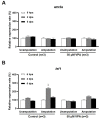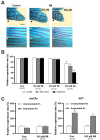Suppressive effects of valproic acid on caudal fin regeneration in adult zebrafish
- PMID: 33456719
- PMCID: PMC7782361
- DOI: 10.1080/19768354.2020.1860126
Suppressive effects of valproic acid on caudal fin regeneration in adult zebrafish
Abstract
Zebrafish can regenerate fins following injury through an epimorphic process that includes the formation of new tissues and reconstruction of the original morphology. In this study, the effects of valproic acid (VPA), a widely used anti-epileptic drug, on fin regeneration were studied after the caudal fin amputation of adult zebrafish. In the control group, zebrafish formed new tissues and reconstructed the original rays 14 days after amputation (dpa). Meanwhile, VPA treatments between 20 and 200 µM following amputation suppressed fin regeneration in a dose-dependent manner and altered morphological characteristics, such as bifurcation and segmentation, in the rays. Compared to the control, VPA also delayed blastema formation and decreased cell proliferation in the mesenchymal area of the regenerated fin. The mRNA expression of lef1, a downstream signaling gene in the Wnt pathway, was transiently increased in the regenerated fin of the control at 2 dpa; the same increase was not observed in the VPA-treated zebrafish. Sodium butyrate (SB), an histone deacetylase activity (HDAC) inhibitor, suppressed the fin regeneration without affecting the morphological characteristics of the regenerated ray. Furthermore, the transient increase of lef1 mRNA was not suppressed in the SB-treated zebrafish. These results suggested that VPA's suppressive effects on fin regeneration are partly mediated through decreased cell proliferation and lef1 mRNA expression.
Keywords: BrdU; caudal fin; regeneration; valproic acid; zebrafish.
© 2020 The Author(s). Published by Informa UK Limited, trading as Taylor & Francis Group.
Conflict of interest statement
No potential conflict of interest was reported by the author(s).
Figures





Similar articles
-
Regrowth of zebrafish caudal fin regeneration is determined by the amputated length.Sci Rep. 2020 Jan 20;10(1):649. doi: 10.1038/s41598-020-57533-6. Sci Rep. 2020. PMID: 31959817 Free PMC article.
-
Induction of lef1 during zebrafish fin regeneration.Dev Dyn. 2000 Oct;219(2):282-6. doi: 10.1002/1097-0177(2000)9999:9999<::aid-dvdy1045>3.3.co;2-3. Dev Dyn. 2000. PMID: 11002347
-
The regenerative capacity of the zebrafish caudal fin is not affected by repeated amputations.PLoS One. 2011;6(7):e22820. doi: 10.1371/journal.pone.0022820. Epub 2011 Jul 28. PLoS One. 2011. PMID: 21829525 Free PMC article.
-
The art of fin regeneration in zebrafish.Regeneration (Oxf). 2015 May 19;2(2):72-83. doi: 10.1002/reg2.33. eCollection 2015 Apr. Regeneration (Oxf). 2015. PMID: 27499869 Free PMC article. Review.
-
Molecular signaling networks that choreograph epimorphic fin regeneration in zebrafish - a mini-review.Gerontology. 2010;56(2):231-40. doi: 10.1159/000259327. Epub 2009 Nov 18. Gerontology. 2010. PMID: 19923791 Free PMC article. Review.
Cited by
-
Transcriptional Signature of Valproic Acid-Induced Neural Tube Defects in Human Spinal Cord Organoids.Int J Stem Cells. 2023 Nov 30;16(4):385-393. doi: 10.15283/ijsc23012. Epub 2023 Aug 30. Int J Stem Cells. 2023. PMID: 37643760 Free PMC article.
-
The Expression and Function of lincRNA-154324 and the Adjoining Protein-Coding Gene vmp1 in the Caudal Fin Regeneration of Zebrafish.Int J Mol Sci. 2022 Aug 11;23(16):8944. doi: 10.3390/ijms23168944. Int J Mol Sci. 2022. PMID: 36012210 Free PMC article.
-
egfl6 expression in the pharyngeal pouch is dispensable for craniofacial development.Anim Cells Syst (Seoul). 2021 Aug 27;25(5):255-263. doi: 10.1080/19768354.2021.1970018. eCollection 2021. Anim Cells Syst (Seoul). 2021. PMID: 34745432 Free PMC article.
-
Advancing ex vivo functional whole-organ prostate gland model for regeneration and drug screening.Sci Rep. 2025 Jan 30;15(1):3758. doi: 10.1038/s41598-025-87039-y. Sci Rep. 2025. PMID: 39885212 Free PMC article.
-
Human Endogenous Retroviruses as Gene Expression Regulators: Insights from Animal Models into Human Diseases.Mol Cells. 2021 Dec 31;44(12):861-878. doi: 10.14348/molcells.2021.5016. Mol Cells. 2021. PMID: 34963103 Free PMC article. Review.
References
-
- Becerra J, Montes GS, Bexiga SRR, Junqueira LCU.. 1983. Structure of the tail fin in teleosts. Cell Tissue Res. 230:127–137. - PubMed
-
- Gurvich N, Berman MG, Wittner BS, Gentleman RC, Klein PS, Green JB.. 2005. Association of valproate-induced teratogenesis with histone deacetylase inhibition in vivo. FASEB J. 19(9):1166–1168. - PubMed
-
- Hartmann C. 2007. Skeletal development – Wnts are in control. Mol Cells. 24(2):177–184. - PubMed
LinkOut - more resources
Full Text Sources
Molecular Biology Databases
